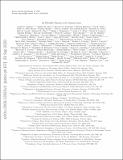An ultrahot Neptune in the Neptune desert
| dc.date.accessioned | 2022-01-18T19:32:31Z | |
| dc.date.available | 2021-10-27T19:56:59Z | |
| dc.date.available | 2022-01-18T19:32:31Z | |
| dc.date.issued | 2020-09 | |
| dc.date.submitted | 2019-07 | |
| dc.identifier.issn | 2397-3366 | |
| dc.identifier.uri | https://hdl.handle.net/1721.1/133848.2 | |
| dc.description.abstract | © 2020, The Author(s), under exclusive licence to Springer Nature Limited. About 1 out of 200 Sun-like stars has a planet with an orbital period shorter than one day: an ultrashort-period planet1,2. All of the previously known ultrashort-period planets are either hot Jupiters, with sizes above 10 Earth radii (R⊕), or apparently rocky planets smaller than 2 R⊕. Such lack of planets of intermediate size (the ‘hot Neptune desert’) has been interpreted as the inability of low-mass planets to retain any hydrogen/helium (H/He) envelope in the face of strong stellar irradiation. Here we report the discovery of an ultrashort-period planet with a radius of 4.6 R⊕ and a mass of 29 M⊕, firmly in the hot Neptune desert. Data from the Transiting Exoplanet Survey Satellite3 revealed transits of the bright Sun-like star LTT 9779 every 0.79 days. The planet’s mean density is similar to that of Neptune, and according to thermal evolution models, it has a H/He-rich envelope constituting 9.0−2.9+2.7% of the total mass. With an equilibrium temperature around 2,000 K, it is unclear how this ‘ultrahot Neptune’ managed to retain such an envelope. Follow-up observations of the planet’s atmosphere to better understand its origin and physical nature will be facilitated by the star’s brightness (Vmag = 9.8). | en_US |
| dc.language.iso | en | |
| dc.publisher | Springer Science and Business Media LLC | en_US |
| dc.relation.isversionof | http://dx.doi.org/10.1038/S41550-020-1142-Z | en_US |
| dc.rights | Article is made available in accordance with the publisher's policy and may be subject to US copyright law. Please refer to the publisher's site for terms of use. | en_US |
| dc.source | arXiv | en_US |
| dc.title | An ultrahot Neptune in the Neptune desert | en_US |
| dc.type | Article | en_US |
| dc.contributor.department | Massachusetts Institute of Technology. Department of Physics | |
| dc.contributor.department | MIT Kavli Institute for Astrophysics and Space Research | |
| dc.contributor.department | Massachusetts Institute of Technology. Department of Earth, Atmospheric, and Planetary Sciences | |
| dc.relation.journal | Nature Astronomy | en_US |
| dc.eprint.version | Author's final manuscript | en_US |
| dc.type.uri | http://purl.org/eprint/type/JournalArticle | en_US |
| eprint.status | http://purl.org/eprint/status/PeerReviewed | en_US |
| dc.date.updated | 2021-09-21T18:14:50Z | |
| dspace.orderedauthors | Jenkins, JS; Díaz, MR; Kurtovic, NT; Espinoza, N; Vines, JI; Rojas, PAP; Brahm, R; Torres, P; Cortés-Zuleta, P; Soto, MG; Lopez, ED; King, GW; Wheatley, PJ; Winn, JN; Ciardi, DR; Ricker, G; Vanderspek, R; Latham, DW; Seager, S; Jenkins, JM; Beichman, CA; Bieryla, A; Burke, CJ; Christiansen, JL; Henze, CE; Klaus, TC; McCauliff, S; Mori, M; Narita, N; Nishiumi, T; Tamura, M; de Leon, JP; Quinn, SN; Villaseñor, JN; Vezie, M; Lissauer, JJ; Collins, KA; Collins, KI; Isopi, G; Mallia, F; Ercolino, A; Petrovich, C; Jordán, A; Acton, JS; Armstrong, DJ; Bayliss, D; Bouchy, F; Belardi, C; Bryant, EM; Burleigh, MR; Cabrera, J; Casewell, SL; Chaushev, A; Cooke, BF; Eigmüller, P; Erikson, A; Foxell, E; Gänsicke, BT; Gill, S; Gillen, E; Günther, MN; Goad, MR; Hooton, MJ; Jackman, JAG; Louden, T; McCormac, J; Moyano, M; Nielsen, LD; Pollacco, D; Queloz, D; Rauer, H; Raynard, L; Smith, AMS; Tilbrook, RH; Titz-Weider, R; Turner, O; Udry, S; Walker, SR; Watson, CA; West, RG; Palle, E; Ziegler, C; Law, N; Mann, AW | en_US |
| dspace.date.submission | 2021-09-21T18:14:53Z | |
| mit.journal.volume | 4 | en_US |
| mit.journal.issue | 12 | en_US |
| mit.license | PUBLISHER_POLICY | |
| mit.metadata.status | Authority Work Needed | en_US |
